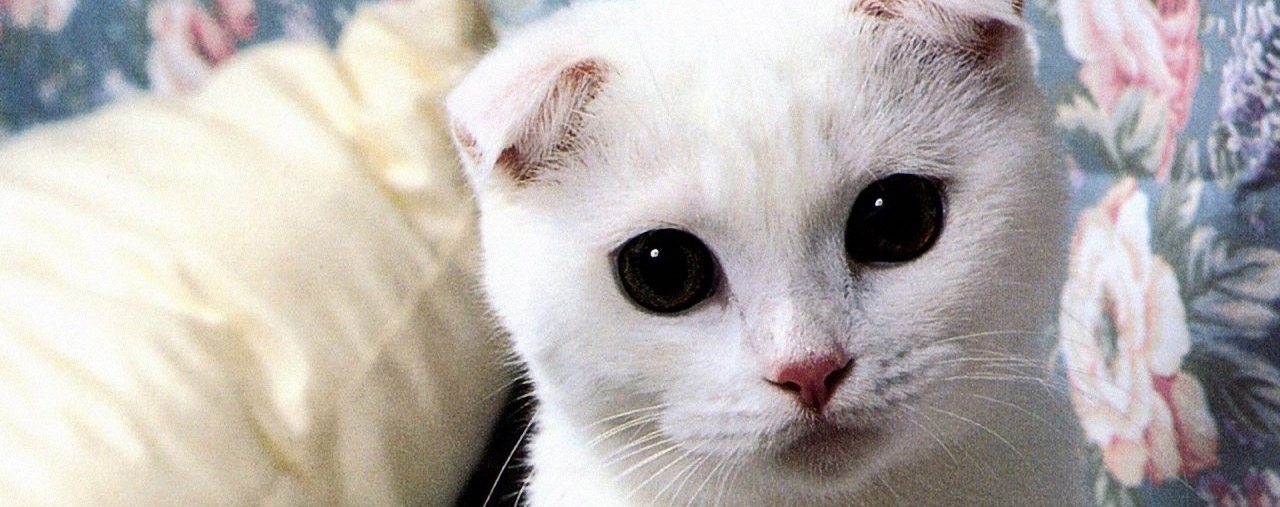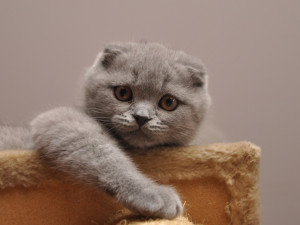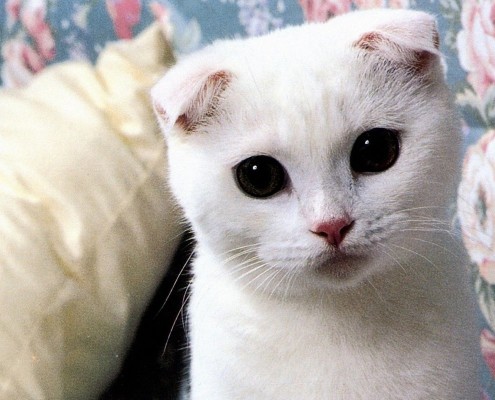Scottish Fold

Meoww!!
The Scottish Fold is of medium size with a solid compact body. The head is rounded with a firm chin and jaw. The nose is gently curved and short.
In 5 Words
- Quiet voiced
- Discreet
- Loving
- Gentle
- Playful
Snapshot
WEIGHT RANGE:
Male: large: >12 lbs.
Female: medium: 8-12 lbs.
EYE COLOR:
Blue, Green, Gold, Odd-eyed
EXPECTATIONS:
Longevity Range: 9-12 yrs.
Social/Attention Needs: Moderate
Tendency to Shed: High
COAT:
Length: Short, Medium, Long
Characteristics: Straight
Colors: White, Blue, Cream, Red, Silver, Cameo, Brown, Bluecream, Tortoiseshell, Black
Pattern: Solid color, Tortoiseshell, Tricolor/Calico, Bicolor, Tabby, Ticking, Smoke, Shaded, Spots
Less Allergenic: No
Overall Grooming Needs: Moderate, High
CLUB RECOGNITION:
Cat Association Recognition:
CFA, ACFA , FIFe, TICA
Prevalence: Rare

Characteristics
Learn About the Scottish Fold
In the mid 1960s, Pat Turner, a cat breeder and geneticist, became involved in the development of the Fold. Over the next 3 years she oversaw the breedings which produced 76 kittens – 42 with folded ears and 34 with straight ears. She and Peter Dyte, another British geneticist, agreed that the gene mutation responsible for folded ears is a simple dominant. This means that if a kitten inherits a gene from one parent for straight ears and one from a parent with the gene for folded ears, it will be a fold. They also learned that the original cats carried the longhair gene.
In 1966, the cats — all sharing a common ancestry to Susie — were named the Scottish fold cat breed. Within 10 years, the breed was one of the most sought-after breeds throughout Europe and America due to its unusual physical trait and its reputation as an affectionate companion. In the early 1970s, however, the GCCF stopped registering folds because of concerns about ear disorders such as infections, mites and deafness – concerns that turned out to be unfounded. Still, the breed never achieved the fame it has attained in North America.
The Scottish Folds are first introduced to the United States in 1970 when three of Snooks’ kittens were sent to Dr. Neil Todd in Massachusetts, who was researching spontaneous mutations. Other folds were later imported, and British and American shorthairs were used in the breeding program. All genuine Scottish folds can be traced back to Suzie. Brought over to the U.S. in the early 70s and registered in the Cat Fanciers’ Association, the shorthair Scottish Fold was entitled to compete for championship status by the 1978-79 show season. The Scottish Fold was granted championship status by the Cat Fanciers’ Association of the United States (CFA) in 1978, and by the Cat Association of Britain in 1984. The CFA only accepts outcrosses to British and American Shorthairs in the pedigrees of registered Scottish Folds, in addition to matings with prick-eared cats from Scottish Fold litters.
The Scottish Fold is of medium size with a solid compact body. The head is rounded with a firm chin and jaw. The nose is gently curved and short. The muzzle is rounded with well-defined whisker pads and the head is set on a short neck. The eyes are large and wide open with a sweet expression and eye colour corresponding to the coat colour. The ears are folded forward and downward. They are small and tightly folded, the smaller and tighter the better. The body is short and rounded. The legs are of medium length and in proportion to the body and the tail tapers to a rounded tip. . The Scottish Foldhas a thick, double coat. All color combinations are accepted, except for chocolate, lavender, the Himalayan pattern, and any combinations of those colors with white.
The Scottish Folds are normally affectionate, calm and well-behaved. They are highly personable and tend to bond well with their entire human and companion pet family. They are hardy animals, owing this in part to their barn cat ancestors. Scottish Folds typically are content in almost any type of household – rural or urban, busy or quiet. Sometimes this cats are watching TV, especially they love cartoons. Scottish Fold kittens quickly learn the rules and regulations of staying in the apartment. Even in the stormy teenage years you will not see the Scottish Fold hanging on the curtains.
This cat has a wonderful disposition. It is a friendly, peaceful and non-dominant cat that will do well in any family including a home with dogs and other cats. They adore their humans, but are not considered lap cats. They are playful and known for their excellent hunting skills. This cat is best described as a quiet-voiced, discreet, loving, gentle and playful cat. The Scottish Fold will adjust to a single and multi-family household. Scottish Fold cats enjoy the company of people and want attention. They will not be happy to live in a home where the inhabitants are away all day.
Both pedigreed cats and mixed-breed cats have varying incidences of health problems that may be genetic in nature.Problems that may affect the Scottish Fold include the following:
Degenerative joint disease, especially in the tail but also in the ankle and knee joints, causing pain or poor mobility. It’s important to handle the tail carefully if it has developed stiffness.
Hypertrophic cardiomyopathy, a form of heart disease, has been seen in the breed, but it has not yet been proven to be a heritable form of the disease.
Epiphora (Excessive Tearing)– Relatives of the Persian and Himalayans are generally more prone to chronic eye irritations and infections that produce tearing and staining of the hair below the eyes. Antibiotics such as Tetracycline are usually prescribed. See cat eye health for more about eye disorders in cats.
Extreme Sensitivities To Anesthetics, Vaccines, And Pesticides Osteodystrophy– A purely genetic abnormality, in which certain bones are deformed from birth, specifically legs and tail vertebrae. The only cure is responsible breeding, i.e. never breeding one Scottish Fold with another.
Sinus Conditions, Specifically Sinusitis- Infection of the frontal sinuses can occur with some frequency, as a secondary effect of a respiratory infection. Watch for a nasal discharge (often just on one side) accompanied by frequent sneezing and sniffling. Sinus issues are usually confirmed with an X-Ray showing increased density in the sinus(es), and are treated with an appropriate antibiotic. If this is not successful, a surgical procedure to make an opening into the sinus through the skin to aid in drainage may be required.
Comb the Scottish Fold’s coat weekly to remove dead hair and distribute skin oils. A longhaired Fold may need to be groomed a couple of times a week to ensure that tangles don’t develop.
Brush the teeth to prevent periodontal disease. Daily dental hygiene is best, but weekly brushing is better than nothing. Trim the nails every couple of weeks. Wipe the corners of the eyes with a soft, damp cloth to remove any discharge. Use a separate area of the cloth for each eye so you don’t run the risk of spreading any infection. Check the ears weekly, especially if they are tightly folded. If they look dirty, wipe them out with a cotton ball or soft damp cloth moistened with a 50-50 mixture of cider vinegar and warm water. Avoid using cotton swabs, which can damage the interior of the ear.
Keep the Scottish Fold’s litter box spotlessly clean. Cats are very particular about bathroom hygiene, and a clean litter box will help to keep the coat clean as well.
It’s a good idea to keep a Scottish Fold as an indoor-only cat to protect him from diseases spread by other cats, attacks by dogs or coyotes, and the other dangers that face cats who go outdoors, such as being hit by a car. Scottish Folds who go outdoors also run the risk of being stolen by someone who would like to have such a beautiful cat without paying for it.
Scottish Folds are not finicky eaters. In fact, care must be taken to help them keep in condition by not overeating, in view of their docile and not too active life style. These cats, as with all pedigreed cats, should never be left outdoors. They traded in their street smarts in exchange for life by the fireside many generations ago. Their cat instincts remain very strong and they will actively admire every bird that comes near the window and will be delighted if a mouse finds its way inside to play with them. They have been observed to be fully capable of performing the same rodent control their British relations are so prized for .






